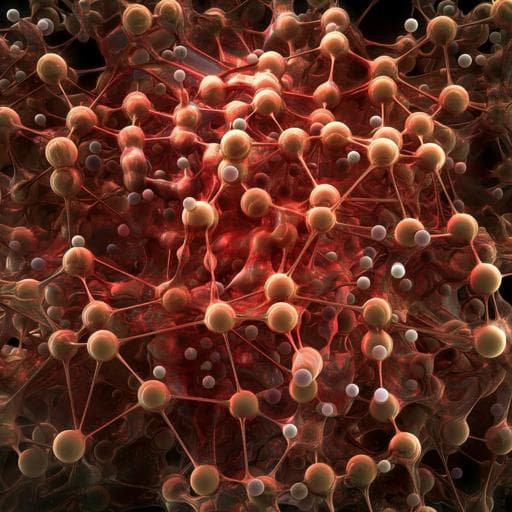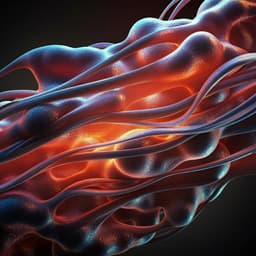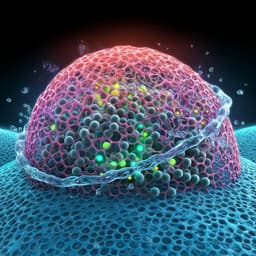
Engineering and Technology
Ultrarobust, tough and highly stretchable self-healing materials based on cartilage-inspired noncovalent assembly nanostructure
Y. Wang, X. Huang, et al.
This groundbreaking research by Yuyan Wang, Xin Huang, and Xinxing Zhang introduces an ultra-robust self-healing material inspired by biological cartilage, featuring exceptional tensile strength, toughness, and healing efficiency. These advancements in noncovalent bonding self-healing materials could revolutionize flexible smart devices.
~3 min • Beginner • English
Introduction
Self-healing materials are sought after for electronic skin, wearable electronics, and artificial muscles, but conventional systems relying on single noncovalent bonds typically exhibit low tensile strength (<3 MPa). A central challenge is overcoming the trade-off between mechanical robustness and healing efficiency, as most reported self-healing materials remain below ~10 MPa tensile strength due to weak noncovalent interactions and poor filler–matrix interfaces. Prior strategies have introduced multiple dynamic bonds or hybrid reversible/covalent networks, improving strength but still short of structural material demands. Nature’s cartilage, with collagen networks and proteoglycan-mediated hydrogen bonding, provides a blueprint for hierarchical, tough, and partially self-healable structures. This work aims to mimic cartilage by creating an interwoven network of rigid 2D nanosheets within a flexible polymer matrix, reinforced by dense interfacial noncovalent bonds, to realize simultaneous ultra-high strength, toughness, stretchability, and efficient self-healing suitable for flexible functional devices.
Literature Review
The authors review limitations of self-healing hydrogels and elastomers with single noncovalent bonds (strength usually <3 MPa) and note most self-healing materials have tensile strength limited to ~10 MPa due to weak noncovalent bonds and poor interfaces. Notable advances include multiple noncovalent cross-linking (Aida et al., tensile strength 26.5 MPa) and combining reversible and permanent covalent cross-links (Xi Zhang et al., 34.0 MPa), yet overall strength remains insufficient for structural applications. Bioinspired strategies assembling rigid networks into soft matrices (e.g., woven fiber networks, plastic skeletons) have achieved ultrahigh mechanical properties but often lack high stretchability due to macroscopic assembly. Cartilage’s hierarchical network of collagen and proteoglycans via hydrogen bonding motivates nanoscale assembly of rigid 2D fillers with strong interfacial interactions to reconcile strength, toughness, stretchability, and healing.
Methodology
Materials: WS₂ powder, tannic acid (TA, 1.7 kDa), waterborne polyurethane (PU), and cellulose nanofibers (CNF) were used as received. Ultrapure water (pH 6.0) was used throughout.
Polyphenol-assisted exfoliation of WS₂: 240 mg WS₂ powder was sonicated in 120 mL water containing 120 mg TA using an ultrasonic cell crusher at 300 W for 2 h. After centrifugation at 4024.8 × g for 15 min, the supernatant containing TA-stabilized WS₂ nanosheets (TA-WS₂) was collected. The TA provides hydrophobic and polyhydroxy interactions to exfoliate and stabilize WS₂ nanosheets.
Preparation of TA-WS₂/PU nanocomposites: TA-WS₂ suspensions at varying loadings (4, 8, 12, 16, 20 wt% relative to PU) were mixed with PU latex (1 g, 60 wt%), stirred 30 min, then vacuum-filtered on a 0.22 μm PP membrane to form films, dried 4 h at room temperature, and peeled from the membrane.
Actuator fabrication: A freestanding CNF film (from 1% CNF dispersion via vacuum filtration on cellulose nitrate membrane) was partially dried, then 10 mL TA-WS₂/PU latex was dispensed on it to form a bilayer. The bilayer dried at room temperature and released from the membrane, enabling thermal-expansion-mismatch-based actuation.
Bionic robots: Origami/kirigami patterning was applied to the bilayer actuators. NIR light (808 nm) on/off control induced reversible deformation; actuation was recorded by camera and angles quantified from images.
Characterization: TEM (JEOL JEM-100CX) assessed nanosheet morphology; XRD (Cu Kα) confirmed crystallinity; Raman (532 nm) probed layer-dependent modes; UV–vis tracked dispersion stability; zeta potential measured colloidal stability; TGA quantified TA content on nanosheets. FTIR (temperature-dependent, 25–170 °C) probed hydrogen bonding; DMA measured glass transition and viscoelasticity; DSC measured thermal transitions; IR thermography monitored photothermal response; SAXS (Xeuss 2.0, 15 keV) conducted in situ during stretching to observe nanostructural orientation and hydrogen-bond dynamics.
Mechanical tests: Dog-bone strips (~15 mm gauge length, 2 mm width, 0.5–0.8 mm thickness) were tested on an Instron 5560 at room temperature (24.2 °C, 46% RH) with 100 mm min⁻¹ strain rate. Healing tests: samples were cut, contacted, and healed 12 h at 25 °C (~50% RH) prior to retesting; healing efficiency η defined as restored toughness fraction. Humidity effects (RH 50–80%) were examined after 2 h equilibration. Cyclic tensile tests to 400% strain for 10 cycles assessed hysteresis/energy dissipation.
Binding energy simulation: Using Materials Studio 2018 with a universal force field, TA and WS₂(001) (9×9 supercell; 50 Å vacuum) were optimized; adsorption locator placed TA over WS₂. An amorphous PU model (three chains, DP=3) was built. Composite models underwent energy minimization and NVT MD at 600 K (TA and WS₂ fixed; PU mobile). Binding energy between PU and fillers was calculated: E_bind = E_PU + E_filler − E_total based on optimized conformations.
Photoinduced mechanical force: A strip (15 mm × 2 mm × 0.05 mm) over an analytical balance was irradiated with 808 nm NIR; generated force F = m·g was recorded as light power varied. Actuation angles and stresses were monitored under periodic NIR on/off cycles.
Key Findings
- Cartilage-inspired design: TA-modified WS₂ nanosheets self-assemble into an interwoven network within PU, with dense interfacial hydrogen bonds, mimicking collagen–proteoglycan interactions.
- Structural characterization: Exfoliated WS₂ nanosheets are monolayer/few-layer (TEM, Raman shifts), highly crystalline (XRD), and stably dispersed (zeta potential −34.2 mV; no aggregation after 30 days). TA content on nanosheets ~14.7 wt% (TGA) after dialysis.
- Strong interfacial interactions: Binding energy between PU and TA-WS₂ is 1356.9 kJ mol⁻¹ versus 10.9 kJ mol⁻¹ for PU with unmodified WS₂, indicating dramatically enhanced interfacial adhesion via TA.
- Supramolecular evidence: Temperature-dependent FTIR shows reversible breaking of hydrogen bonds (shifts in OH, NH, and C=O bands) upon heating; DMA shows increased Tg with TA-WS₂ (15.75 °C) vs WS₂/PU (7.35 °C), reflecting restricted chain mobility due to supramolecular crosslinks.
- Nanostructure under strain: In situ SAXS reveals strain-induced orientation of the WS₂ network; increased scattering at q ≈ 0.032 Å⁻¹ with strain and a peak at q ≈ 1.3 nm⁻¹ attributed to hydrogen-bond break/reconstruction; control (unmodified WS₂) shows much weaker orientation and a thinner interfacial layer (2.34 nm → 0.27 nm).
- Mechanical performance (optimal at 16 wt% TA-WS₂): tensile strength 52.3 MPa; toughness 282.7 MJ m⁻³; elongation at break 1020.8% (~1.6×, 8.0×, and 16.4× that of pristine PU, respectively). Mechanical properties are relatively insensitive to RH 50–80%.
- Self-healing: Room-temperature autonomous healing (12 h contact) yields high efficiencies depending on filler content: 16 wt% shows η ≈ 80.6% with maximal strength/toughness; 8 wt% achieves highest healing efficiency η ≈ 105.1% without external stimulus. Healed samples can be stretched from 1.5 to 16.0 cm and lift a 500 g weight.
- Energy dissipation: Cyclic tensile tests (400% strain, 10 cycles) show larger hysteresis and improved energy dissipation due to reversible noncovalent bond breaking/reforming; fully recover after healing.
- Comparison: The toughness (282.7 MJ m⁻³) exceeds many polymers and even spider dragline silk (1.6×) and aluminum (9.4×), outperforming many self-healing materials and typical PU composites with rigid fillers.
- NIR actuation and functional healing: Actuators exhibit rapid photothermal response with bending to 137° in 0.9 s (808 nm); actuation stress up to ~6.9 kPa at 0.6 W; performance is maintained after self-healing with comparable bending dynamics and cyclic reliability; demonstrated biomimetic flower and crawling robot with reversible NIR-driven motion.
Discussion
The work addresses the long-standing trade-off between mechanical robustness and self-healing by emulating cartilage’s hierarchical architecture at micro/nanoscale. TA-modified WS₂ nanosheets create a percolated interwoven network within PU, while dense interfacial hydrogen bonds act as dynamic crosslinks that both reinforce and enable healing. Under load, the interfacial noncovalent bonds break and reform, orienting the network, dissipating energy, and driving strain-induced microphase separation for self-reinforcement, thereby delivering simultaneous high strength, toughness, and stretchability. The markedly higher binding energy of PU to TA-WS₂ compared to bare WS₂ evidences the central role of interfacial supramolecular design. The robust, reconfigurable interfacial network further enables functional healing in devices, with NIR actuation performance fully restored after damage. These results demonstrate that noncovalent, interface-focused assembly of rigid 2D fillers into polymer matrices can overcome the presumed incompatibility of high robustness and healing, expanding the design space for flexible, durable devices.
Conclusion
A cartilage-inspired, microscale/nanoscale assembly strategy was developed to fabricate ultrarobust, highly stretchable, and self-healing PU nanocomposites by embedding TA-modified WS₂ nanosheets that self-assemble into an interwoven network with dense interfacial hydrogen bonds. The materials achieve exceptional mechanical properties (52.3 MPa tensile strength, 282.7 MJ m⁻³ toughness, 1020.8% elongation) alongside high self-healing efficiencies (≈80–105%) at room temperature and demonstrate fully recoverable NIR actuation. The interfacial supramolecular crosslinking is key to both structural reinforcement and healing, providing a generalizable approach to high-performance self-healing structural materials and flexible functional devices, including artificial muscles. Future work could explore broader 2D fillers, optimize interfacial chemistry, and scale-up processing for practical device integration.
Limitations
Performance depends on filler content: at high loading (20 wt% TA-WS₂), mechanical properties abruptly decrease due to WS₂ aggregation in PU, hindering chain mobility and restricting recovery of broken hydrogen bonds. Optimal performance occurs at intermediate contents (e.g., 16 wt% for strength/toughness; 8 wt% for peak healing efficiency).
Related Publications
Explore these studies to deepen your understanding of the subject.







